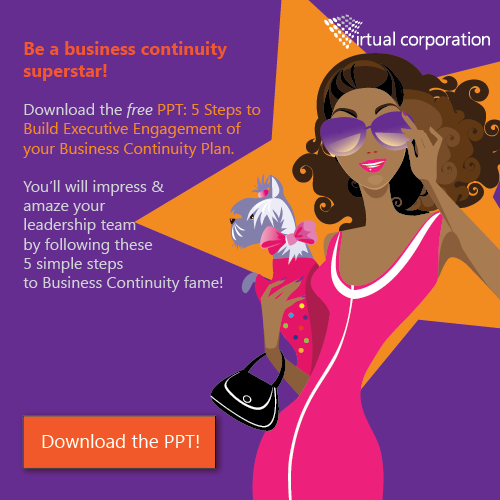Camels, and Astronauts, and Resilience... Oh My!
Resilience, organizational resilience, business continuity, building engagement, disaster recovery, virtual planner
You may have noticed we launched a new look and feel at Virtual Corporation, that we think better matches our philosophy and even lets us have a little fun. I thought I would explain our thought process on our new imagery and organizational resilience planning overall.

I think the choice of camels was an obvious one. Camels are considered to be one of the most resilient animals. They can go for days or weeks without water across grueling temperatures and terrains. I think the same can be said of business continuity, organizational resilience and risk managers, although, I don’t recommend going that long without water. :)
As for astronauts, you can bet we would never have safely landed a man on the moon or launched anyone in space without a well thought out resilience plan. Although not every organization’s mission may be as involved as launching a successful space program, we believe that every resilience management program should be viewed as mission critical.
Toto, I've a feeling we're not in Kansas anymore.
The world is changing. Just consider the amazing advances we have had in technology alone. Of course the more advanced we get the more we need to ensure business continuity. The increase in various threats that include hackers, cyber and other terroristic events, natural and man-made disasters, have brought increased awareness of the need for disaster recovery, business continuity and organizational resilience planning. Disruption of business or operations from any type of “event”, natural or man-made, accidental or intentional, internal or external, with or without prior warning can have an immediate impact. Is your organization prepared?
The solution: Dynamic resilience planning. This encompasses a living resilience, disaster recovery or business continuity plan that adapts and changes with the evolution of your organization and its environment. The days of dusting off a complicated business continuity document that sits on the shelf are over. Plans need to be operational in real-time and adaptable to new data, technology and processes.
 |
I'll get you my pretty, and your little camel, too!
|
Maybe you don’t really have to face the wicked witch of the west, but there are many challenges and challengers that you may battle on the path to resilience. As if disruptive events aren’t enough, sometimes the biggest challenges to achieving an optimal organizational resilience management program come from internal organizational dynamics.
Some of these challenges include:
- Financial: Lack of budget, funds and resources
- Executive buy-in: Lack of top management commitment, buy-in and support
- Enterprise engagement: Lack of business unit support
- Prioritization: The low priority given to BCM compared to other deliverables
- Apathy: Organizational apathy towards BCM
- Recruitment: Finding the right business continuity program manager
- Time: Lack of time available for business continuity staff to manage all their task
The solution: Data. Statistics. Facts. There are plenty of statistics, quantifiable data and relevant high profile events that support the need for organizational resilience planning. Find examples that are specific to your organization, geographic location or industry to help make the case for resilience planning.
- Financial: Determine the cost of not having a dynamic business continuity plan or program. There are many free tools that can help you determine your maturity or risk. Business Continuity Matuirty Model.
- Executive Buy-in: This is considered to be one of the biggest challenges to building an business continuity program. You might find some tips here.
- Enterprise Engagement: Each department can be impacted by disruptive events and needs to be a part of the planning process.
- Prioritization: Use the data, facts and statistics from the above items. Simply put, organizational resilience needs to be an ongoing priority.
- Apathy: Pointing out high profile disruptive events or disasters is a good place to start. Quantifying continuity from an organizational perspective can help, too.
- Recruitment: Check out some of the broader resilience organizations such as Disaster Recovery Journal (DRJ) or Disaster Recovery Institute International (DRII).
- Time: The right solutions can help you optimize planning time. This may end up being a combination of many tools such as software, templates or consultants.
Pay no attention to that man behind the curtain.
After a long trip down the yellow brick road of resilience, you may come across software and solutions that promise to solve all your business continuity planning problems as if from a magical wizard. Wouldn’t it be great if real life worked that way? Some of these flashy, inflexible solutions look like they have all the bells and whistles, but what is really happening behind the curtain? We have seen that organizational resilience tends not to be so one size fits all. The plan needs to fit the industry, the organization and the specific mission and culture of the individual organization.
The solution: Instead of looking for the Emerald City or the great and powerful Wizard of Resilience, consider a hybrid approach to resilience that may include:
- Customizable planning solutions
- Industry-specific templates and best practices built-in
- Consultants who also have a deep knowledge of your specific industry
- Education via white papers, online courses or industry conferences like Disaster Recovery Journal (DRJ) or Disaster Recovery Institute International (DRII)
- User groups that let you network and share best practices with your peers
- Online resources such as the Disaster Resource Guide

Then close your eyes and tap your heels together three times.
The best way to ensure business is to know your organizational risk and create a reliable plan that is tested and repeatable. Be sure to have regular reviews and updates of recovery plans. Consider integrating critical data directly into your planning software to automatically update.
No matter which tools and resources you choose, you will never be sorry you planned for resilience and disaster recovery.
Resilience, organizational resilience, business continuity, building engagement, disaster recovery, virtual planner


